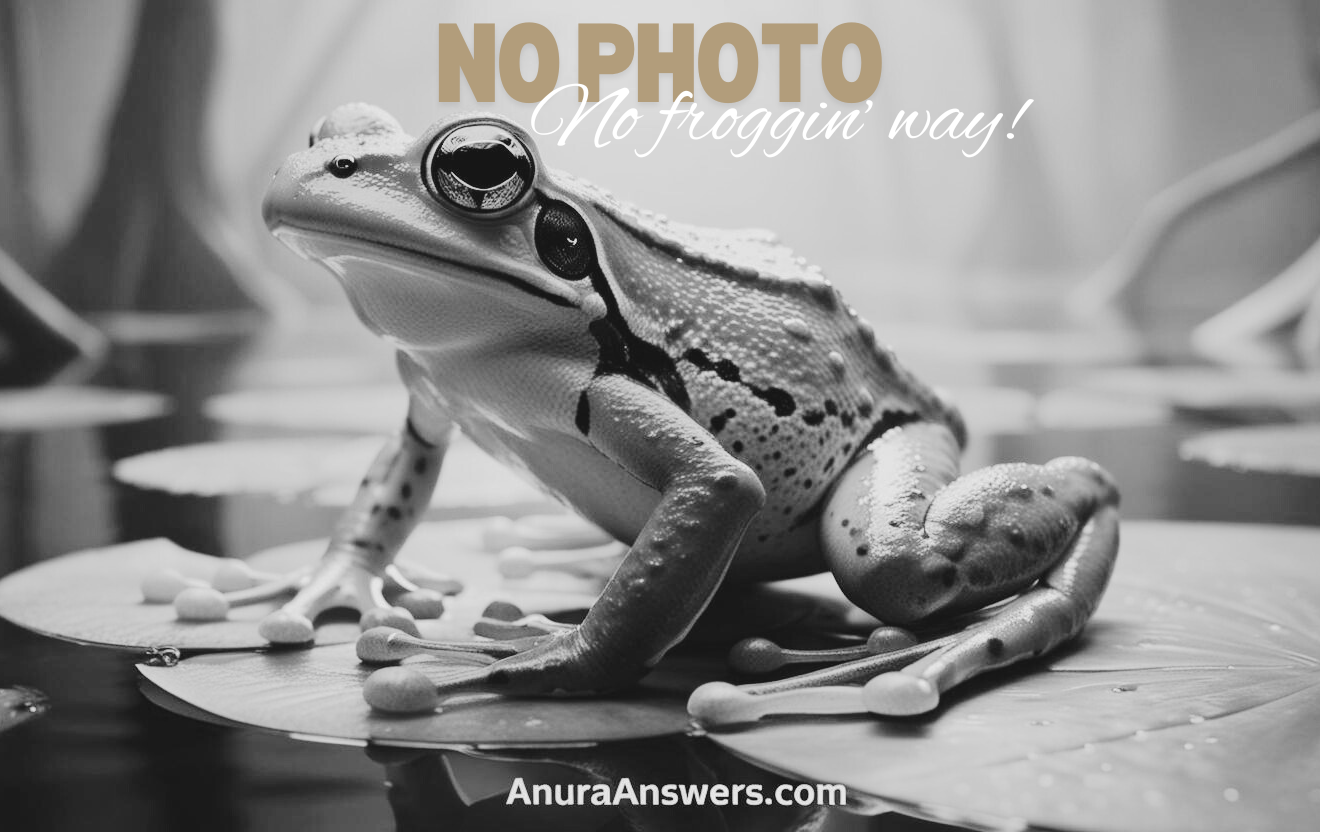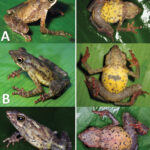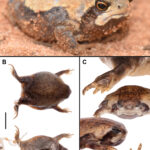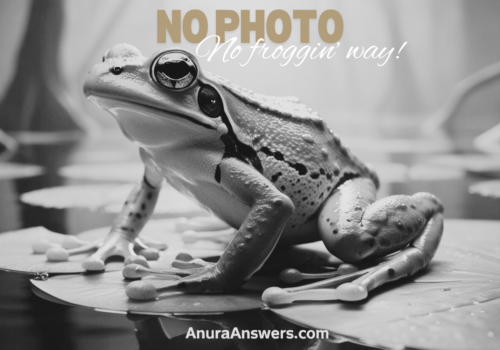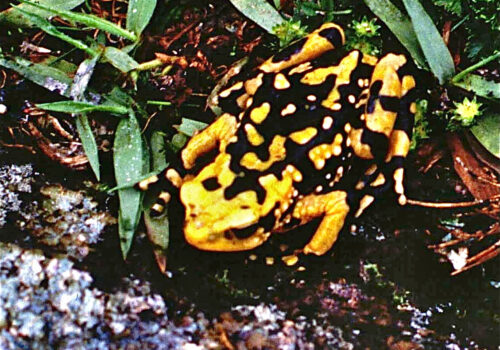- Unveiling the Mysteries of the Amazonian Jewel: Atelopus pedimarmoratus
- Taxonomy and Classification: Understanding Its Place in Nature's Tapestry
- Natural Habitat: A Jewel in the Amazon's Crown
- Physical Characteristics: The Artistry of Evolution
- Behavior and Life Cycle: Rhythms of an Amphibious Life
- Ecological Role: Guardians of Healthy Ecosystems
- Threats and Conservation Status: Guardians Under Siege
- Cultural and Scientific Significance: Beyond Scientific Inquiry
- Conclusion: Towards a Future Shared with the Amazonian Harlequin Frog
Unveiling the Mysteries of the Amazonian Jewel: Atelopus pedimarmoratus#
Deep within the lush and vibrant rainforests of the Amazon basin dwells a creature whose presence tells us much about the health of our planet. Its brilliant colors mesmerize naturalists, its habitats reveal symphonies of biodiversity, and at the very heart of its story lies a tale as profound as it is delicate—the tale of Atelopus pedimarmoratus, the Amazonian Harlequin Frog.
At first glance, a harlequin frog might appear a creature of fantasy, seemingly painted by an artist inspired by a palette of fiery sunsets and verdant rivers. Yet, while undeniably enchanting, it also symbolizes nature’s vulnerability: this remarkable amphibian is an ambassador of ecosystems that face mounting threats and warrants our attention and empathy.
Join me as we step into the mist-covered forests and quietly flowing streams of the Amazon to intimately explore the captivating life and pressing plight of Atelopus pedimarmoratus.
Taxonomy and Classification: Understanding Its Place in Nature’s Tapestry#
The Amazonian Harlequin Frog, scientifically recognized as Atelopus pedimarmoratus, belongs to the Bufonidae family—a diverse lineage more familiarly known as true toads. Yet, this unique genus, Atelopus, diverges dramatically from typical perceptions of toads, boasting vibrant hues and graceful forms rather than the duller shades we often associate with their relatives.
Within the genus Atelopus are around 100 species, each adapted loyally to its ecosystem. However, Atelopus pedimarmoratus holds special interest, inhabiting specific territories within the Amazon basin and demonstrating both the resilience and fragility of these ecosystems. The name “pedimarmoratus” itself evokes imagery of marbled feet, aptly describing the species’ distinct patterning and aesthetic appeal.
Natural Habitat: A Jewel in the Amazon’s Crown#
Nestled amid the shadows of towering Kapok trees and bathed in perpetually damp air, the habitat of Atelopus pedimarmoratus is nothing short of wondrous. Found predominantly across certain areas of Ecuador, Peru, Brazil, and Colombia, the species thrives along the cool, clear freshwater streams and tributaries that drain these lush territories.
Imagine yourself standing beside one of these Amazonian rivulets: overhead glistens a canopy of emerald leaves filtering scattered rays of sunlight, birdsong complements the gentle ripples of water, and beneath your feet, the spongy earth hums with quiet life. It is precisely in this peaceful refuge that the Amazonian Harlequin Frog makes its home, dependent upon unpolluted waters and stable microclimates that sustain an unparalleled richness of flora and fauna.
These frogs prefer the proximity of crystal-clear water both for reproduction and as a sanctuary from predators and climate extremes. Streams shaded by dense vegetation, with moss-covered stones and steady, moderate currents, are particularly essential, providing the ideal conditions for egg-laying and larval development. Indeed, preserving these specific habitats directly impacts the survival of Atelopus pedimarmoratus.
Physical Characteristics: The Artistry of Evolution#
Marveling at the Amazonian Harlequin Frog initiates a journey into nature’s artistic prowess. Adult frogs typically range from 2.5 to 4 centimeters in length, a petite stature belying their significance in the ecosystem. Yet, their true magic lies in their striking coloration and intricate patterning.
The species showcases spectacular hues of vibrant yellow, leaf-green, or golden-orange, intricately speckled or marbled with contrasting darker markings, particularly on their ventral surfaces and limbs. These bright, vivid colors serve more than merely aesthetic pleasure—they signify toxicity, a stern warning to potential predators that consuming them would result in bitter, even deadly, consequences. This defensive strategy, known as aposematic coloration, is a profound testament to nature’s evolutionary ingenuity.
The limbs and digits of Atelopus pedimarmoratus are long, slender, and agile, perfectly adapted for gripping mossy rocks and maneuvering gracefully along slippery stream banks. Their large eyes and alert postures reveal a keen awareness of their surroundings, critical for their survival in such dynamic habitats.
Behavior and Life Cycle: Rhythms of an Amphibious Life#
Feeding and Daily Life#
Gentle and unobtrusive predators, Amazonian Harlequin Frogs predominantly feed on small insects and other invertebrates, expertly ambushing their prey with precision leaps. Timid and elusive, they spend much time hidden beneath leaves, rocks, and roots near streams, sheltered from the piercing eyes of diurnal predators.
Breeding Patterns and Development#
When breeding season arrives, usually synchronized with periods of increased rainfall, male harlequin frogs congregate near streams and rivers, proclaiming their presence through distinctly soft, chirping calls. These vocalizations serve both to attract females and deter rival males, creating an intimate symphony beneath the rainforest canopy.
A male frog attracts a receptive female through his persistent calling, after which the pair engages in a mating embrace known as amplexus. Females deposit their clutches of gelatinous eggs in secluded pools or gently flowing waters, ensuring optimal conditions for the eggs’ development.
Tadpoles emerge roughly two weeks later, specialized for a swift aquatic existence, navigating current-rich waters and filtering nutrients from their surroundings. The journey from tiny tadpole to fully formed, air-breathing froglet symbolizes adaptability, resilience, and transformation—the hallmarks of amphibian life.
Ecological Role: Guardians of Healthy Ecosystems#
In ecosystems brimming with biodiversity, each species fulfills a crucial niche. As both predator and prey, Atelopus pedimarmoratus significantly impacts local food webs. They control insect populations, contributing to the ecological balance essential for vibrant rainforest health. Conversely, their survival depends particularly upon thriving, insect-rich habitats, positioning them sensitively within the web of Amazonian diversity.
Yet another vital role is their function as bioindicators. Amphibians’ permeable skin and life cycle intimately tied to aquatic habitats mean subtle environmental changes manifest dramatically in frog populations. Declines in harlequin frog numbers thus serve as early warnings for biologists, alerting us to potential environmental threats.
Threats and Conservation Status: Guardians Under Siege#
Despite their evolutionary resilience, Amazonian Harlequin Frogs face significant threats, many stemming undeniably from human activities. Habitat destruction driven by logging, mining, agricultural expansion, and dam construction poses immediate existential threats. Such disruptions lead to fragmented populations, polluted waterways, and dramatic ecosystem changes.
Perhaps the most insidious and heartbreaking threat is the deadly chytrid fungus (Batrachochytrium dendrobatidis), responsible globally for unprecedented amphibian declines. Combined with climate change—altering rainfall patterns and temperatures—chytrid outbreaks gain intensity, devastating harlequin frog communities rapidly and silently.
Currently, the species is considered critically endangered by the International Union for Conservation of Nature (IUCN), underscoring the urgency and responsibility that human communities carry toward its conservation.
Cultural and Scientific Significance: Beyond Scientific Inquiry#
Indigenous communities inhabiting Amazonian territories revere amphibians like the harlequin frog as symbols of renewal and the interconnectedness of life. Storytelling traditions often depict frogs as guides between water and land, bridging realms symbolic of change and transformation.
Scientifically, research surrounding harlequin frogs has yielded critical insights into evolutionary biology, ecosystem health, and emerging infectious diseases—a remarkable contribution highlighting their significance beyond aesthetic appreciation.
Conclusion: Towards a Future Shared with the Amazonian Harlequin Frog#
The saga of Atelopus pedimarmoratus is a poignant reflection of Earth’s forests’ intricate beauty and alarming fragility. Conserving this captivating species means much more than safeguarding a single amphibian; it signifies our dedication toward a thriving planet—a harmonious coexistence between humanity and nature.
Awareness, activism, habitat protection, and collaborative conservation offer tangible pathways forward. Inspired by creatures as remarkable as the Amazonian Harlequin Frog, let each of us become advocates, guardians, and storytellers, ensuring that their quiet chirps continue to resonate through the Amazon, reverberating an authentic testament of life’s resilience for generations to come.
